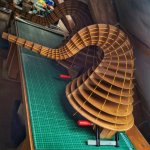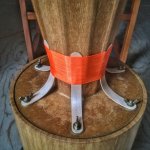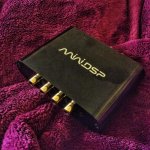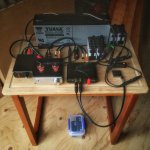FWIW, my understanding is that it's an OB until it's folded up enough to acoustically load it within its pass-band [Fhm = 2*Fs/Qts'], so must be pretty big to load a high Qts' driver even once the room's boundaries are accounted for. GM
Thank you for the reminder, I really do like these really big front loaded horns. Busy doing other things right now with visuals, and thinking about my next speaker build this winter, somewhere along the lines of maybe 6ft x 3ft x 6ft with no speaker cabinet ......
Been very busy over the last year with various creative art projects, as well as health care giving duties, and during the Spring finally started work on a pair of swan necked front loaded Tractrix horn speakers. These are to give additional stereo information to what is now a much listened to 4ft wide LeCleach horn, using 3inch Peerless 830987 full range speakers. The spec is (allegedly!) 50hz to 18khz, but around 200hz and upwards with a generous overlap with the LeCleach will do me fine.
It has been quite a difficult build so far. Modelling in HornResp until I came up with something realistic took some doing when the enclosure size is just one litre. This time, I have chosen to build a set of formers to cover in paper mache in order to get a swan neck curve, and to say the least, it has not been easy. I have had to employ ‘Cathedral type thinking’ from the get-go. The idea is to use guy ropes made of trimmer wire to pull and hold together what is still a wobbly edifice of cardboard, and although it all appears to be working, and I am learning a great deal ...... I won’t be doing it the same way next time!
Here is a nice picture of the build so far. ToS
It has been quite a difficult build so far. Modelling in HornResp until I came up with something realistic took some doing when the enclosure size is just one litre. This time, I have chosen to build a set of formers to cover in paper mache in order to get a swan neck curve, and to say the least, it has not been easy. I have had to employ ‘Cathedral type thinking’ from the get-go. The idea is to use guy ropes made of trimmer wire to pull and hold together what is still a wobbly edifice of cardboard, and although it all appears to be working, and I am learning a great deal ...... I won’t be doing it the same way next time!
Here is a nice picture of the build so far. ToS
Attachments
Fascinating endeavor and looks like excellent craftsmanship thus far. Have you seen John Inlow's website(1)?
On his 15a page, and likely others you can see his approach to layered horn building. You can see in the picture of the horn half molds that he uses expanding foam between the 'ribs' of the mold so he can then cover in, what looks like plaster, then likely paints it with something to help the layered molded pieces release. He might discuss this on his paper mache horn pages as well.
It could be of some use to you as a potential stiffener for the ribs in your molds.
Cheers,
Gable
1 - inlowsound.com
On his 15a page, and likely others you can see his approach to layered horn building. You can see in the picture of the horn half molds that he uses expanding foam between the 'ribs' of the mold so he can then cover in, what looks like plaster, then likely paints it with something to help the layered molded pieces release. He might discuss this on his paper mache horn pages as well.
It could be of some use to you as a potential stiffener for the ribs in your molds.
Cheers,
Gable
1 - inlowsound.com
Fascinating endeavor and looks like excellent craftsmanship thus far. Have you seen John Inlow's website(1)?
On his 15a page, and likely others you can see his approach to layered horn building. You can see in the picture of the horn half molds that he uses expanding foam between the 'ribs' of the mold so he can then cover in, what looks like plaster, then likely paints it with something to help the layered molded pieces release. He might discuss this on his paper mache horn pages as well.
It could be of some use to you as a potential stiffener for the ribs in your molds.
Cheers,
Gable
1 - inlowsound.com
Gable,
I am a huge fan of John Inlow, a very ingenious man, and have studied his work in depth. His varied use of materials is simply brilliant. There is something within me that refuses to verbatim copy other people, as I believe it to be unfair. What he does is what he does, and what I do is what I do. Nevertheless, I find his dedication very inspiring, as he has proved to me that it is possible to work entirely with recycled paper products alone.
I like to see the limitations that I have imposed upon myself as a spur to invention. Rather than make horn speakers as massively heavy immovable objects, I have gone the opposite way, and see horns as lightweight musical instruments in their own right, with timbre and colouration of sound that enhances the playback of music - or that is the theory!
At the moment, I am making it all up as I go along. Each success, and each mistake shows the way to the next step. It is very exciting making musical sculptures in this way, and I love the whole process of working slowly and carefully in pursuit of excellence.
ToS
I often limit myself to specific tools, or try to solve things without google. I've found that discipline in this method can lead to great leaps of learning and understanding.
It does tend to lead to some frustration, and mistakes, but that's part of the benefit, IMO.
If I've read correctly thus far, you are going to use your big le'cleach horn for ~50-250hZ coverage and the in process goose-neck horns for ~200hZ and up?
I may need to go back and re-read the thread to confirm that. Was a bit curious if you had plans to try to cover lower frequencies than ~50hZ?
I am enjoying following your progress, your dedication, creative designing and building have made this a fascinating project to follow.
Cheers,
Gable
It does tend to lead to some frustration, and mistakes, but that's part of the benefit, IMO.
If I've read correctly thus far, you are going to use your big le'cleach horn for ~50-250hZ coverage and the in process goose-neck horns for ~200hZ and up?
I may need to go back and re-read the thread to confirm that. Was a bit curious if you had plans to try to cover lower frequencies than ~50hZ?
I am enjoying following your progress, your dedication, creative designing and building have made this a fascinating project to follow.
Cheers,
Gable
I often limit myself to specific tools, or try to solve things without google. I've found that discipline in this method can lead to great leaps of learning and understanding.
It does tend to lead to some frustration, and mistakes, but that's part of the benefit, IMO.
If I've read correctly thus far, you are going to use your big le'cleach horn for ~50-250hZ coverage and the in process goose-neck horns for ~200hZ and up?
I may need to go back and re-read the thread to confirm that. Was a bit curious if you had plans to try to cover lower frequencies than ~50hZ?
I am enjoying following your progress, your dedication, creative designing and building have made this a fascinating project to follow.
Cheers,
Gable
Gable,
Glad that you are enjoying the build.
At present, the LeCleach is fitted with a 6.5in alnico guitar speaker, and with eq, it gives a fairly good impression of bass, mids and treble, and is at its best between upper bass and mid treble. The horn is incredibly efficient due to its size, the amp is under run, and so gives quite a good musical account of itself.
But I want the treble frequencies to articulate stereo information, and so I am building the smaller Tractrix horns.
The bass comes next, and I am thinking of a 10” Eminence BP10-4ohm in a tube firing upwards underneath the small table the LeCleach sits on. I don’t need a massive bass sound, just enough to compliment the projected soundscape.
At first, I shall see what I will be able to do with signal splitters and guitar pedals to eq and time delay the sound, but I reckon the real way to go is a miniDSP 2x4 HD with two channels for stereo, and two dedicated mono channels for the LeCleach and bass. If it all makes me want to get up and sing and dance, then I will have succeeded.
ToS
When I originally mated together the waveguide and speaker enclosure during construction, I made absolutely sure that the join between the two was glued properly and reinforced with multiple overlapping layers of brown paper. It worked, but I always had doubts as to whether or not the weight of the enclosure would eventually buckle the joint.
In the spring, I decided to do something about it, and made a series of flying buttresses made out of tongue depressors. These were drilled and soaked in hot water to soften them, then bent and strapped around a cardboard tube with cling film. While still damp, I put them in place under the brass bolts around the waveguide to dry out to fit to shape. Finally, I bound the buttresses to the waveguide with braided builders line, which has enough elasticity to really clamp everything in place. Cost of materials was less than £1.
When I fired up the horn speaker, I noticed that the sound quality had changed for the better. This was completely unexpected. It seems that the buttresses actually channel turbulent vibration away from the front compression chamber into the structure of the waveguide, and gives more clarity and separation of instruments in the lower midrange of sound. Sure enough, when putting my ear to the horn mouth, I could hear the difference as transmitted sound through the structure.
It has got me thinking a lot about how to make rigid yet lightweight speaker enclosures with the extensive use of bracing. Somewhat like building a monkey house for musical sound to live in.
tapestryofsound
Here is a picture:-
In the spring, I decided to do something about it, and made a series of flying buttresses made out of tongue depressors. These were drilled and soaked in hot water to soften them, then bent and strapped around a cardboard tube with cling film. While still damp, I put them in place under the brass bolts around the waveguide to dry out to fit to shape. Finally, I bound the buttresses to the waveguide with braided builders line, which has enough elasticity to really clamp everything in place. Cost of materials was less than £1.
When I fired up the horn speaker, I noticed that the sound quality had changed for the better. This was completely unexpected. It seems that the buttresses actually channel turbulent vibration away from the front compression chamber into the structure of the waveguide, and gives more clarity and separation of instruments in the lower midrange of sound. Sure enough, when putting my ear to the horn mouth, I could hear the difference as transmitted sound through the structure.
It has got me thinking a lot about how to make rigid yet lightweight speaker enclosures with the extensive use of bracing. Somewhat like building a monkey house for musical sound to live in.
tapestryofsound
Here is a picture:-
Attachments
Damn clever idea for further securing the driver chamber to horn throat joint. It seems you could mix some glue, or varnish to coat the builders twine around the tongue depressors. Not sure if it's needed, but it might make the joint more permanent and less likely to move over time.
So much fun watching your progress!
So much fun watching your progress!
Damn clever idea for further securing the driver chamber to horn throat joint. It seems you could mix some glue, or varnish to coat the builders twine around the tongue depressors. Not sure if it's needed, but it might make the joint more permanent and less likely to move over time.
So much fun watching your progress!
pcgab,
Interesting that you make this observation.
Not many folk have a listening room set up in the hayloft of a barn, and to build something that will survive in a Highland climate under a tin roof of extremes of heat and cold, both wet and dry, is a real challenge.
After I had set up and dried out the buttresses, they were able to keep their own shape, and so I massaged in copious amounts of beeswax. The waveguide was already coated with beeswax, and the builders line, under about 75% of its stretch, bit into the wood, and by capillary action wicked up some of the beeswax, too. It simply does not budge, and by design there is enough give in the structure to absorb any accidental knocks without cracking.
I got the inspiration from looking at the flying buttresses holding up Notre Dame on Google Earth 3D at the time of the fire.
tapestryofsound
Excellent solution. The climate was what I was most concerned with, temperature and humidity swings causing movement. It sounds like you have it well sorted. Smart to allow some flexibility and movement, as they _will_ move and if too rigid, would break.
I need to go find the images of Notre Dame, now I'm interested to see them!
Cheers,
Gable
I need to go find the images of Notre Dame, now I'm interested to see them!
Cheers,
Gable
Something rather splendid happened yesterday. I received a small airmail package sent by a diyAudio member, who happened to have a surplus miniDSP 2x4, and kindly gave it to me. Such generosity!
It was in perfect condition with not a mark or a scratch anywhere. I have wanted one for quite awhile now, as I really am not all that interested in passive eq. My initial idea was to build two smaller swan-necked Tractrix horns to sit on either side of the big Le Cleache - not enough room in a hayloft ........ oh well, but then I remembered that I have got a pair of small low wattage Dayton flat panel vibration (DML) speakers sitting on a shelf waiting for my attention.
OK, so this what I intend to do - I am going to mount the DML’s transducers on either side behind the front lip of the Le Cleache, and use the miniDSP to sort it all out. Gets even better, I have a real nice Eminence 10inch bass guitar speaker that I can mount in a massive terracotta plant pot, and fire it upwards from below using the Le Cleache as a sympathetic soundboard. Again, the miniDSP can sort it all out.
That’s the idea, and as nobody as yet has told me I cannot do this, so I will go ahead and do it anyway!
tapestryofsound
Here is another nice picture - very glam, eh?
It was in perfect condition with not a mark or a scratch anywhere. I have wanted one for quite awhile now, as I really am not all that interested in passive eq. My initial idea was to build two smaller swan-necked Tractrix horns to sit on either side of the big Le Cleache - not enough room in a hayloft ........ oh well, but then I remembered that I have got a pair of small low wattage Dayton flat panel vibration (DML) speakers sitting on a shelf waiting for my attention.
OK, so this what I intend to do - I am going to mount the DML’s transducers on either side behind the front lip of the Le Cleache, and use the miniDSP to sort it all out. Gets even better, I have a real nice Eminence 10inch bass guitar speaker that I can mount in a massive terracotta plant pot, and fire it upwards from below using the Le Cleache as a sympathetic soundboard. Again, the miniDSP can sort it all out.
That’s the idea, and as nobody as yet has told me I cannot do this, so I will go ahead and do it anyway!
tapestryofsound
Here is another nice picture - very glam, eh?
Attachments
tapestryofsound
Here is another nice picture - very glam, eh?
Gary Glitter would be proud!
I wonder how the DMLs will sound, could be interesting. Only one way to find out!
The classic front loaded tractrix horn has to be the Voigt Domestic Corner Horn. The original Voigt, or later Lowther drivers have anything but a flat FR, but the combination (which I measured for a friend who had reproduced a pair!) was amazingly even. I do not know how much of the output was strictly horn loaded, but the front output was 90Hz upwards.
I have also seen and heard the same driver in a non corner horn (possibly also by Voigt) with a 4 foot square mouth. Huge, but pretty impressive.
I have also seen and heard the same driver in a non corner horn (possibly also by Voigt) with a 4 foot square mouth. Huge, but pretty impressive.
The classic front loaded tractrix horn has to be the Voigt Domestic Corner Horn. The original Voigt, or later Lowther drivers have anything but a flat FR, but the combination (which I measured for a friend who had reproduced a pair!) was amazingly even. I do not know how much of the output was strictly horn loaded, but the front output was 90Hz upwards.
I have also seen and heard the same driver in a non corner horn (possibly also by Voigt) with a 4 foot square mouth. Huge, but pretty impressive.
This is very interesting for me. When I first built my Le Cleach, I was a little bit disappointed with the sound quality, very good on the mids, but otherwise lacking - that is - until I put the signal through a very good stereo guitar multieffect pedal that takes a line input. Quite an extraordinary difference. And now, I am going to enter the world of measuring audio using a miniDSP and a Umike, to see how far I can push my luck before it all falls apart.
The real dream for me, the one I am aiming for, is to find the right full range driver with a perfectly designed waveform that needs no eq at all. What you say about the seemingly disparate Lowther drive in the Voight horn measures with a flat response is very encouraging.
tapestryofsound
MiniDSP installed
Of course the pandemic comes along and changes everything. And I finally have the opportunity to set up my MiniDSP 2x4 with a mono 31 band equaliser plug-in. I have a Umik and REW, but it’s a steep learning curve, and I just wanted to listen to some music. It sounds very nice. Crisp and well defined, but sure to be tweeted at a later date.
Here is a picture showing it altogether. The MiniDSP is 18v, valve buffer 12v and the class D mono amp 24v. Lots of headroom and easy on the ear.
Of course the pandemic comes along and changes everything. And I finally have the opportunity to set up my MiniDSP 2x4 with a mono 31 band equaliser plug-in. I have a Umik and REW, but it’s a steep learning curve, and I just wanted to listen to some music. It sounds very nice. Crisp and well defined, but sure to be tweeted at a later date.
Here is a picture showing it altogether. The MiniDSP is 18v, valve buffer 12v and the class D mono amp 24v. Lots of headroom and easy on the ear.
Attachments
Awesome battery powered setup!
Covid has certainly caused everyone's plans to change dramatically. Glad to hear you got your system setup so you can make the most of these times.
Yes, Covid-19 seems to concentrate the mind, wonderfully.......
Over this last week I have been putting the MiniDSP 2x4 through its paces in conjunction with a Umik calibrated mic and REW. Let me say that REW is quite complex and will take quite awhile (as in years!) for me to fully understand. However, the waterfall analysis - truly invaluable to the visually orientated like myself.
I have been programming the MiniDSP in mono with the ‘rear centre speaker plug-in’ on and off over the last few days - very interesting when looked at in REW with all the combing visible in the waterfall. The input and output line signals were a bit hot and clippy, so I dropped them -12 and -4db respectively. Eventually the waterfall began to reflect the listening experience, and the MiniDSP plug-in’s 31 channel EQ was pulling quite an astonishing amount of detail and dynamics from quite a modest 6in driver.
Everything was sounding so good, I pulled my valve buffer out of the signal path altogether, as it seems to no longer serve any useful purpose. By now I had the MiniDSP running on its maximum 24 volts, and the entire audio chain is now playing back all kinds of music with consummate ease. I think I am ready now to start work on building a subwoofer to take it onto the next level.
- Status
- This old topic is closed. If you want to reopen this topic, contact a moderator using the "Report Post" button.
- Home
- Loudspeakers
- Full Range
- Suitability of Alpair 10M Gen 3 For Front Loaded Horn



